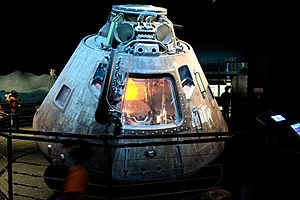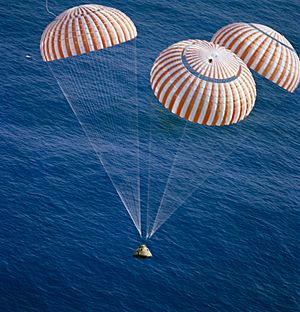Fe, Fi, Fo, Fum, and Phooey facts for kids




Fe, Fi, Fo, Fum, and Phooey were five special mice. They traveled all the way to the Moon in 1972. These mice circled the Moon 75 times during the Apollo 17 mission. NASA gave them official numbers like A3326 and A3400. But the astronauts on Apollo 17 gave them their fun nicknames.
The Apollo 17 crew included Eugene Cernan, Harrison Schmitt, and Ronald Evans. Four male mice and one female mouse orbited the Moon with astronaut Ronald Evans. They stayed in orbit for over six days inside the Apollo command module America. Meanwhile, Cernan and Schmitt explored the Moon's surface. This was the last time humans walked on the Moon during the Apollo program.
Sadly, one mouse (A-3352) did not survive the trip. The other four mice returned safely to Earth. Scientists then studied them closely to learn how space travel affected living things. The three astronauts and the five mice were the last Earthlings to travel to and orbit the Moon. Ronald Evans and the mice hold two space records. They spent the longest time in lunar orbit (147 hours, 43 minutes). They also completed the most lunar orbits (75).
The Apollo 17 Mission
The Apollo 17 mission began on December 7, 1972. It ended when the spacecraft returned to Earth on December 19. The mice were part of a science experiment called BIOCORE. This experiment studied how cosmic rays might affect living things.
Why Pocket Mice?
The scientists chose five pocket mice (Perognathus longimembris) for this experiment. These mice were a good choice for several reasons:
- They were very small.
- They were easy to care for in a small space.
- They did not need drinking water for the mission's length.
- They produced very little waste.
- They were known to handle stress well.
Studying Cosmic Rays
Scientists placed tiny radiation monitors under the mice's scalps. This helped them see if cosmic rays would cause any harm. Four of the five mice survived the long journey. The reason for the fifth mouse's death was not clear.
After their return, the four surviving mice were studied by scientists. They found some small marks on their scalps and livers. However, these marks did not seem connected to each other. Scientists did not think cosmic rays caused them. No damage was found in the mice's eyes or other internal organs. Later studies showed no major effects on the mice's brains either.
Images for kids
See also
 In Spanish: Fe, Fi, Fo, Fum y Phooey para niños
In Spanish: Fe, Fi, Fo, Fum y Phooey para niños


